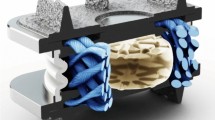Abstract
The Dynesys dynamics stabilisation system was developed to maintain the mobility of motion segment of the lumbar spine in order to reduce the incidence of negative effects at the adjacent segments. However, the magnitude of cord pretension may change the stiffness of the Dynesys system and result in a diverse clinical outcome, and the effects of Dynesys cord pretension remain unclear. Displacement-controlled finite element analysis was used to evaluate the biomechanical behaviour of the lumbar spine after insertion of Dynesys with three different cord pretensions. For the implanted level, increasing the cord pretension from 100 to 300 N resulted in an increase in flexion stiffness from 19.0 to 64.5 Nm/deg, a marked increase in facet contact force (FCF) of 35% in extension and 32% in torsion, a 40% increase of the annulus stress in torsion, and an increase in the high-stress region of the pedicle screw in flexion and lateral bending. For the adjacent levels, varying the cord pretension from 100 to 300 N only had a minor influence on range of motion (ROM), FCF, and annulus stress, with changes of 6, 12, and 9%, respectively. This study found that alteration of cord pretension affects the ROM and FCF, and annulus stress within the construct but not the adjacent segment. In addition, use of a 300 N cord pretension causes a much higher stiffness at the implanted level when compared with the intact lumbar spine.




Similar content being viewed by others
References
Mulholland RC, Sengupta DK (2002) Rationale, principles and experimental evaluation of the concept of soft stabilization. Eur Spine J 11:S198–S205
Mayer HM, Korge A (2002) Non-fusion technology in degenerative lumbar spinal disorders: facts, questions, challenges. Eur Spine J 11:85–91
Grob D, Benini A, Junge A, Mannion AF (2005) Clinical experience with the Dynesys semirigid fixation system for the lumbar spine. Spine 30:324–331
Stoll TM, Dubois G, Schwarzenbach O (2002) The dynamic neutralization system for the spine: a multi-center study of a novel non-fusion system. Eur Spine J 11:S170–S178
Vaga S, Brayda-Bruno M, Perona F, Fornari M, Raimondi MT, Petruzzi M, Grava G, Costa F, Caiani EG, Lamartina C (2009) Molecular MR imaging for the evaluation of the effect of dynamic stabilization on lumbar intervertebral discs. Eur Spine J 18:S40–S48
Schaeren S, Broger I, Jeanneret B (2008) Minimum four-year follow-up of spinal stenosis with degenerative spondylolisthesis treated with decompression and dynamic stabilization. Spine 33:E636–E642
Würgler-Hauri CC, Kalbarczyk A, Wiesli M, Landolt H, Fandino J (2008) Dynamic neutralization of the lumbar spine after microsurgical decompression in acquired lumbar spinal stenosis and segmental instability. Spine 33:E66–E72
Freudiger S, Dubios G, Lorrain M (1999) Dynamic neutralization of the lumbar spine confirmed on a new lumbar spine simulator in vitro. Arch Orthop Trauma Surg 199:127–132
Schmoelz W, Huber JF, Nydegger T, Dipl-Ing, Claes L, Wilke HJ (2003) Dynamic stabilization of the lumbar spine and its effects on adjacent segments: an in vitro experiment. J Spinal Disord Tech 16:418–423
Schmoelz W, Huber JF, Nydegger T, Claes L, Wilke HJ (2006) Influence of a dynamic stabilisation system on load bearing of a bridged disc: an in vitro study of intradiscal pressure. Eur Spine J 15:1276–1285
Rohlmann A, Burra NK, Zander T, Bergmann G (2007) Comparison of the effects of bilateral posterior dynamic and rigid fixation devices on the loads in the lumbar spine: a finite element analysis. Eur Spine J 16:1223–1231
Zander T, Rohlmann A, Burra NK, Bergmann G (2006) Effect of a posterior dynamic implant adjacent to a rigid spinal fixator. Clin Biomech 21:767–774
Niosi CA, Zhu QA, Wilson DC, Keynan O, Wilson DR, Oxland TR (2006) Biomechanical characterization of the three-dimensional kinematic behaviour of the Dynesys dynamic stabilization system: an in vitro study. Eur Spine J 15:913–922
Niosi CA, Wilson DC, Zhu Q, Keynan O, Wilson DR, Oxland TR (2008) The effect of Dynamic posterior stabilization on facet joint contact forces. Spine 33:19–26
Liu CL, Zhong ZC, Shih SL, Hung C, Lee YE, Chen CS (2010) Influence of Dynesys system screw profile on adjacent segment and screw. J Spinal Disord Tech 23:410–417
Shirazi-Adl A, Ahmed AM, Shrivastava SC (1986) Mechanical response of a lumbar motion segment in axial torque alone and combined with compression. Spine 11:914–927
Panagiotacopulos ND, Pope MH, Krag MH, Block R (1987) Water content in human intervertebral discs. Part I. Measurement by magnetic resonance imaging. Spine 12:912–917
Zhong ZC, Chen SH, Hung C (2009) Load- and displacement-controlled finite element analyses on fusion and non-fusion spinal implants. Proc Inst Mech Eng H 223:143–157
Chen SH, Zhong ZC, Chen CS, Chen WJ, Hung C (2009) Biomechanical comparison between lumbar disc arthroplasty and fusion. Med Eng Phys 31:244–253
Goel VK, Grauer JN, Patel TCh et al (2005) Effects of charité artificial disc on the implanted and adjacent spinal segments mechanics using a hybrid testing protocol. Spine 30:2755–2764
Cheng BC, Gordon J, Cheng J, Welch WC (2007) Immediate biomechanical effects of lumbar posterior dynamic stabilization above a circumferential fusion. Spine 32:2551–2557
Rohlmann A, Zander T, Rao M, Bergmann G (2009) Applying a follower load delivers realistic results for simulating standing. J Biomech 42:1520–1526
Acknowledgments
This study was partly supported by National Science Council (NSC 99-2221-E-075-001-MY2) and Veterans General Hospitals (V98C1-078).
Conflict of interest
None.
Author information
Authors and Affiliations
Corresponding author
Rights and permissions
About this article
Cite this article
Liu, CL., Zhong, ZC., Hsu, HW. et al. Effect of the cord pretension of the Dynesys dynamic stabilisation system on the biomechanics of the lumbar spine: a finite element analysis. Eur Spine J 20, 1850–1858 (2011). https://doi.org/10.1007/s00586-011-1817-3
Received:
Revised:
Accepted:
Published:
Issue Date:
DOI: https://doi.org/10.1007/s00586-011-1817-3




